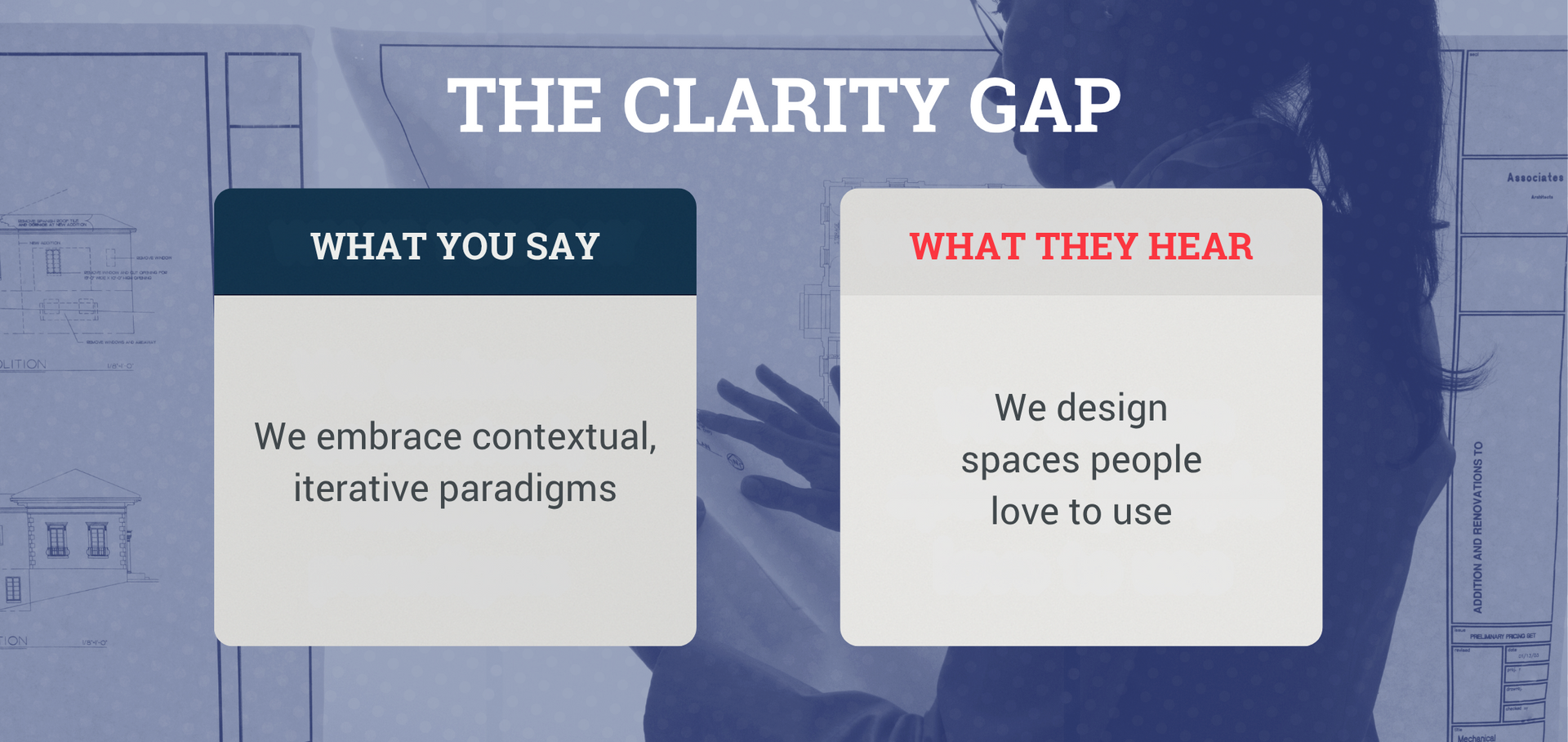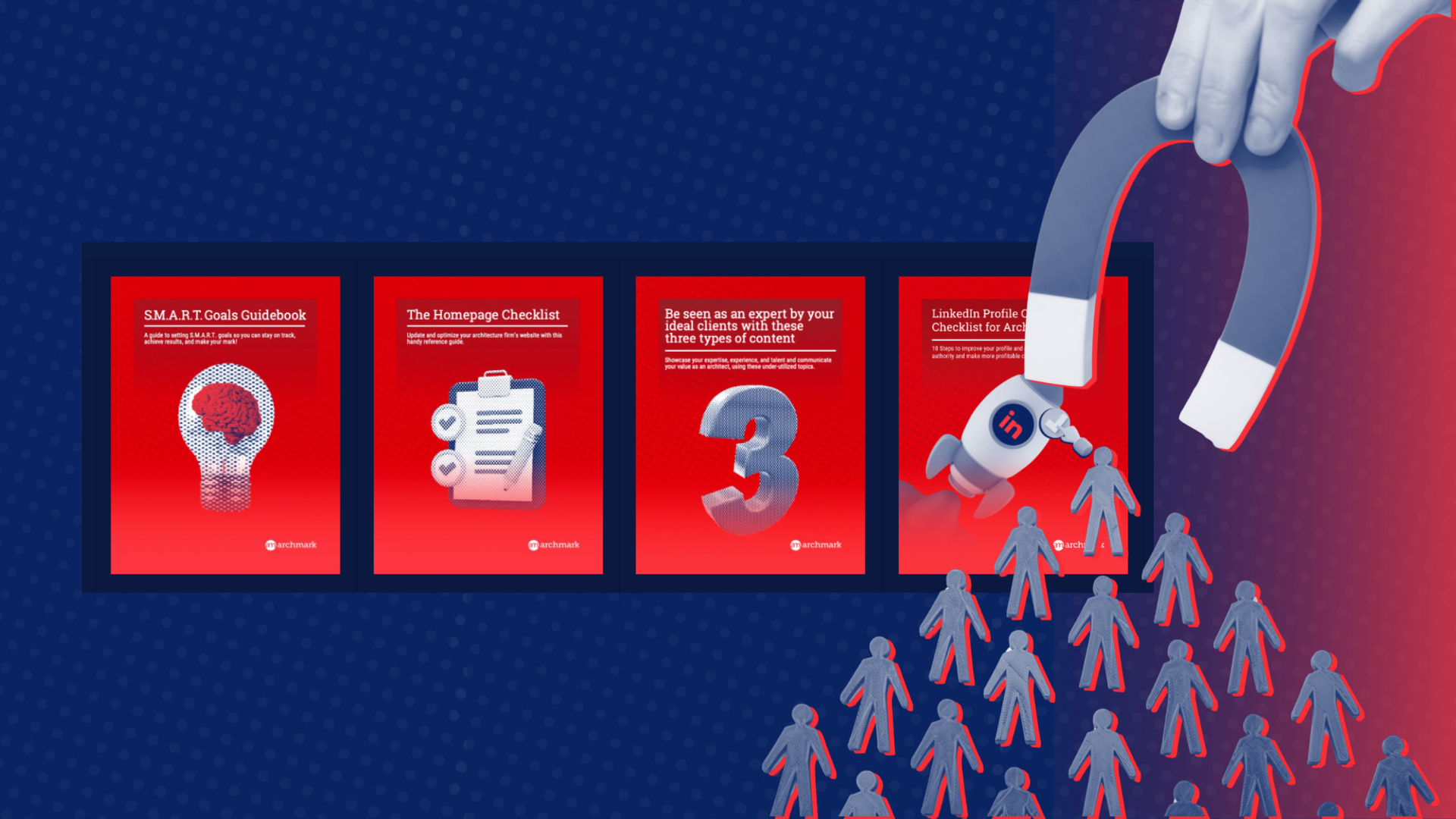Communication in Architecture: Cut Through Jargon and Connect with Clients
The Real Cost of Jargon: Rethinking Communication in Architecture
Let's be honest—if architecture firms were restaurants, most of their menus would read: "Locally-sourced cylindrical wheat-based carbohydrate structures horizontally presented with tomato reduction and dairy protein spheres."
But normal humans would call it: spaghetti and meatballs.
Welcome to the weird and wonderful world of "Archibabble"— that peculiar language architects seem to slip into the moment they start marketing themselves.
You've seen it. Those impressive-sounding but utterly baffling phrases like "contextual spatial relationships"and "ephemeral luminosity.”
As the CEO of Archmark, the branding and marketing agency dedicated specifically to architects, I've seen firsthand how this language barrier creates an invisible wall between talented architects and the clients who need them.
Let's explore why this happens and how to break down this wall to connect with your prospects authentically.
The Hidden Cost of Complexity
When an architecture firm fills its website with technical terminology, something fascinating happens in the brain of potential clients.
Rather than being impressed, their brains actually start working overtime, burning more calories to decipher the meaning.
And the human brain, being the efficient energy-conservation machine that it is, will often choose to simply disengage rather than work too hard to understand your message.
In fact, research shows that if a prospective client can't understand your offer within five seconds, they're likely to abandon your website and move on to a competitor who communicates more clearly.
Five seconds.
That's all you get to make a first impression.
Think about it this way: Your beautiful, jargon-filled description of your design philosophy might be intellectually stimulating to fellow architects, but to a business owner looking to build a new office space, it's rather annoying.
Learn how to simplify your architecture marketing plan in 9 steps.

The Clarity Gap: What You Say vs. What They Hear
Noise: The Silent Killer of Architecture Businesses
In today's overcommunicated world, "noise" is perhaps the most significant obstacle facing architecture firms trying to attract new clients.
Jargon and technical language contribute directly to this noise, obscuring your actual message.
Noise kills ideas, services, and results by drowning them in complexity.
Effective communication involves not just what you say, but what you choose not to say, keeping your message simple and focused.
At Archmark, we've helped dozens of architecture firms cut through this noise by simplifying their messaging.
The results are often dramatic—increased website engagement, more qualified leads, and ultimately, more projects won.
See how we’ve helped firms break through with better communication.

The Intellectual Trap: When Smart People Overcomplicate
Beyond Confusion: The Business Cost of Archibabble
1. Lost Opportunities
2. Diminished Value Perception
Paradoxically, trying to sound sophisticated through complex language can actually diminish how valuable your services appear. When you fail to clearly articulate the problems your clients face and how you solve them, you inadvertently suggest that their challenges aren't that significant—which cheapens the perceived value of your solutions.
3. Marketing Investment Waste
If you're investing in a beautiful website, regular email campaigns, and active social media presence but communicating with Archibabble, you're essentially throwing money away. No matter how much you spend on marketing assets, if your message isn't clear, it will be ignored.
Learn how effective digital marketing helps architecture firms grow.
4. Prolonged Sales Cycles
When clients can't easily understand your value proposition, sales cycles stretch out unnecessarily as you spend additional time explaining and re-explaining your services, eating into your profitability and creating frustration on both sides.
The External vs. Internal Problem Disconnect
Examples: The Archibabble Transformation
- Before (Archibabble): "Our contextually responsive design methodology interrogates the spatial and programmatic parameters to deliver a phenomenologically rich user experience that transcends mere functionality."
- After (Clarity): "We design buildings that solve your specific needs while creating memorable spaces that your people will love to use every day."
- Before (Archibabble): "Our iterative design process employs parametric modeling to optimize the building envelope's performance relative to environmental conditions."
- After (Clarity): "We use advanced technology to design buildings that significantly reduce your energy costs while providing comfortable, beautiful spaces."
How to Escape the Archibabble Trap
If you recognize your firm's marketing in some of these examples, don't worry—you're not alone, and there's a clear path forward.
Here are practical steps to transform your communication:
1. Adopt a Client-Centered Perspective
Before writing any marketing content, ask yourself: "Would a non-architect understand this?" Better yet, show your website or marketing materials to friends or family members outside the architecture world and ask them to explain what you do based on what they read.
2. Focus on Outcomes, Not Processes
Clients care less about your design methodology and more about what your design will do for them. Instead of describing your "integrated design approach," explain how your buildings help businesses attract top talent, reduce operating costs, or enhance productivity.
3. Use Simple Language for Complex Ideas
Challenge yourself to explain your unique approach without using any technical terms. This exercise often reveals the core value more clearly than jargon ever could.
4. Tell Stories, Not Specifications
Human brains are wired for stories, not abstract concepts. Share brief case studies that focus on the client's challenge, your solution, and the resulting transformation—all in simple, concrete language.
5. Address the Emotional Dimension
Acknowledge the internal struggles clients face when embarking on a building project. Are they worried about going over budget? Concerned about disruption to their operations? Anxious about whether the result will reflect their vision? Directly addressing these concerns shows empathy and builds trust.
The Clarity Advantage
Firms that move beyond Archibabble gain a significant competitive advantage. When you communicate clearly:
- You stand out immediately in a sea of confusing competitors
- You reduce friction in the client acquisition process
- You build trust through transparency and accessibility
- You attract clients who value clear communication (hint: these are often the best clients)
- You set the stage for smoother projects with fewer miscommunications
At Archmark, we've seen architecture firms transform their businesses by simply changing how they talk about their work.
One firm we worked with saw a 67% increase in qualified leads within three months of clarifying their messaging—with no increase in marketing spending.
The Client's Brain: Conserving Energy at All Costs
Understanding a bit about how the human brain works explains why clarity is so crucial.
Our brains are constantly working to conserve energy.
When faced with information that's difficult to process, the brain has two options: work harder to understand it, or simply disengage and move on to something easier.
In most cases—especially in marketing contexts—the brain chooses the second option. This isn't laziness; it's efficient design.
Your potential clients aren't allocating their limited mental energy to deciphering your complex terminology when competitors are making their lives easier with clear, simple messages.
This is why even brilliant architects with exceptional portfolios sometimes struggle to attract clients while firms with simpler, clearer messaging thrive.
The quality of your work matters, but it can't speak for itself if
potential clients
never get past your confusing website or proposal.

The Path Forward: Clarity Without Compromise
Some architects worry that simplifying their language means "dumbing down" their work or not fully representing its sophistication.
This is a fundamental misunderstanding of what effective communication looks like.
Clarity doesn't mean oversimplification.
It means thoughtfully translating complex ideas into accessible language that respects your audience's intelligence while acknowledging their different knowledge base.
The most respected architects in history—from Louis Kahn to Zaha Hadid—could explain their revolutionary ideas in ways that connected with both peers and clients. Their ability to communicate clearly enhanced rather than diminished their genius.
Taking Action: Your Next Steps
If you're convinced that your firm needs to move beyond Archibabble, here are practical next steps:
- Audit Your Current Materials: Review your website, proposals, and other marketing materials with fresh eyes (or better yet, non-architect eyes). Highlight instances of technical language that could be simplified.
- Rewrite Your Core Message: Can you explain what makes your firm special in one simple sentence? Try crafting a clear statement of value that anyone could understand.
- Start Small: Begin by clarifying the most important parts of your marketing—your homepage, your service descriptions, and your project highlights.
- Get Feedback: Test your new messaging with people outside the architecture world. If they can easily explain what you do and why it matters after reading your materials, you're on the right track.
- Consider Professional Help: Sometimes it's difficult to see our own blind spots. Working with marketing professionals who understand both architecture and clear communication (like our team at Archmark) can accelerate your transformation.
Clarity Is Your Competitive Advantage
In an industry where technical expertise is plentiful but clear communication is rare, architects who can speak plainly about their value stand out dramatically.
By breaking free from Archibabble, you remove barriers between your firm and the clients who need your expertise.
Remember: your brilliant designs deserve an equally brilliant communication strategy—one that connects rather than confuses, engages rather than alienates, and ultimately builds bridges to the clients who will value your work most.
Ready to Break Free from Archibabble?
If you're an architecture firm owner ready to transform how you communicate your value, Archmark is here to help.
Our team specializes exclusively in branding and marketing for architects, combining deep industry knowledge with proven communication strategies.
Take the first step toward clarity by applying for a free Clarity Call. In just 30 minutes, we'll help identify your biggest communication opportunities and outline specific steps to connect more effectively with ideal clients.
Your exceptional architecture deserves exceptional marketing. Let's make sure your message is as clear and compelling as your designs.
Frequently Asked Questions (FAQ)
1. What does “communication in architecture” really mean?
It refers to how architects express ideas, concepts, and value—both visually and verbally—to clients, consultants, and communities. Strong communication means making complex design thinking clear and relatable, ensuring that everyone involved in a project understands its goals and benefits.
2. Why is jargon a problem in architecture marketing?
Jargon creates a barrier between architects and clients. When firms use overly technical language, potential clients disengage because they can’t quickly understand what’s being offered. This confusion can lead to lost leads, longer sales cycles, and a perception that the firm is pretentious or out of touch.
3. How can architects communicate more clearly with clients?
Focus on outcomes, not processes. Instead of describing your “iterative, contextually responsive methodology,” explain how your designs help clients save money, improve productivity, or create spaces people love. Clear, benefit-focused messaging connects emotionally and intellectually with clients.
4. What is the “5-second rule” in architecture marketing?
Research shows that website visitors form impressions within five seconds. If they can’t understand what you do in that time, they’ll likely leave. Simplifying your homepage message and visuals helps you capture attention before it’s gone.
5. Does simplifying your language make your firm sound less professional?
Not at all. Simplifying isn’t dumbing down—it’s smart communication. The most respected architects can explain complex ideas simply. Clarity shows confidence and mastery of your subject.
6. What are some examples of clear versus confusing messaging?
- Confusing: “Our design methodology interrogates spatial and programmatic parameters to deliver phenomenological experiences.”
- Clear: “We design spaces that solve your needs and make every day more enjoyable.” The clear version communicates value instantly—no dictionary required.
7. How can firms test whether their communication is clear?
Ask people outside the profession to read your website or marketing materials. If they can easily explain what your firm does and why it matters, you’re on the right track.
8. How does poor communication affect project success?
When clients and architects aren’t aligned due to unclear communication, misunderstandings multiply. This can lead to scope creep, frustration, and even strained relationships. Clear, consistent messaging from the first meeting reduces these risks.
9. How can firms start improving communication today?
- Audit your website for jargon and overly technical terms.
- Replace complex phrases with benefit-driven language.
- Tell short stories or case studies instead of listing services.
- Address both the emotional and practical needs of clients.
- Consider booking a free Clarity Call with Archmark to evaluate your messaging strategy.
10. What’s the biggest takeaway about communication in architecture?
Clarity is your competitive advantage. The ability to communicate complex design ideas simply and authentically helps you stand out, attract better clients, and build stronger relationships. Great architecture deserves great communication.











